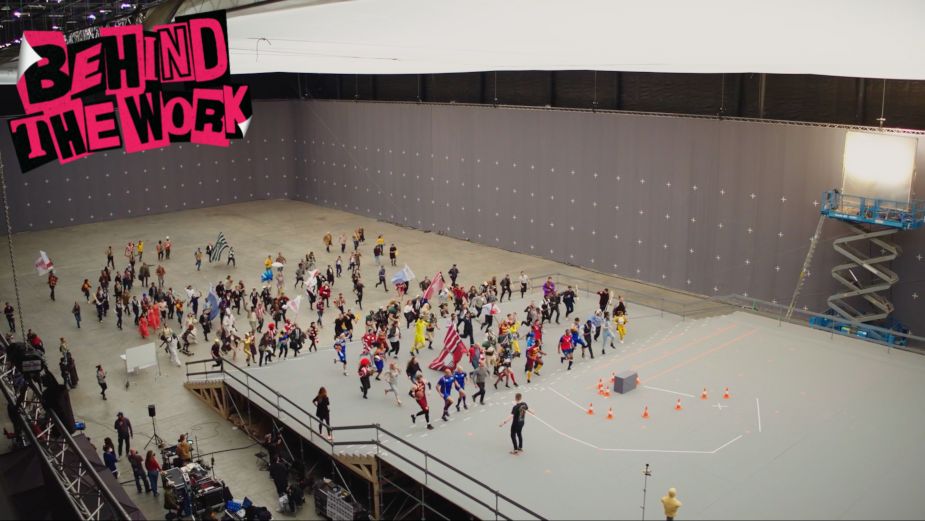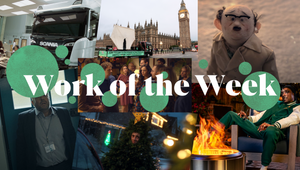
How Ladbrokes Put Rocky “On the Right Side of Bonkers”

Two weeks ago, Ladbrokes launched what was deemed the most ambitious use of VFX for character replacement in Hollywood history. Neverland creative has worked with the brand in previous spots as part of the ‘Let’s Play Together’ campaign (‘Drummers’ and ‘Balloon’), but this time, in the words of Greg Spencer, creative director at Selected Works, they wanted to make it “even bigger.” And you can’t really go much bigger than remaking Rocky Balboa’s famous Phillie run, but with the original cast digitally replaced with hundreds of modern sports people, drag queens, dancers, gymnasts and others.
Neverland worked alongside post production house Selected Works on the incredibly complicated process of replacing the crowd behind Rocky and still keeping the grain, colours and other elements of the sequence. The process not only included an incredible amount of mathematics, but also bespoke technology and a combination of CGI with a number of other tools. This and heaps of research, planning and meticulously studying the original scene is just the beginning of Selected Works’ winning formula for the film, explains Greg. “Collaboration is so important. [The] communication and teamwork on this project was incredible.”
LBB’s Zoe Antonov spoke to Greg about the creative direction behind the project, the specifics of the VFX process and how they managed to pull off one of the most impressive VFX stunts in adland history.
LBB> What was the brief for this project and how did this idea come about?
Greg> Neverland had produced two previous spots for Ladbrokes as part of the same ‘Let’s Play Together’ campaign, and this time they were tasked with making it even bigger – it doesn’t get much bigger than this! The first part of our brief was figuring out how to do it (and even if it could be done). At Selected Works we strive to create completely seamless VFX - utterly believable and realistic. We were acutely aware of just how iconic the original material was, and the care needed to re-engineer it for Ladbrokes.
LBB> This was undoubtedly the most ambitious character replacement in Hollywood history. What kind of technology was used to achieve it at such a large scale?
Greg> A combination of CGI tools such as Blender, Maya and Houdini; compositing was done in Nuke and Flame, colour grading in Baselight; and in-house proprietary tools were specifically written by Selected Works for the bespoke challenges and complexities of this project.
LBB> Take us through the process of how this was achieved, for all the people out there who don't fully understand how VFX works at such a scale.
Greg> A lot of research and planning was needed up front. We carefully studied the original film, so we could work with production to develop a camera system and technique that would allow us to re-create all the camera moves.
Nicolai made a decision early on that he wanted to film all the characters in one layer. We agreed with this as it meant the characters could all interact with each other and overall, even though much more difficult, would add to the realism of the composites and help with performance.
VFX is a team sport. So many different people were involved in the process. We began with a recce of the original film locations in Philadelphia, where we measured the streets, steps and bridges and took lidar scans to give us rough CGI models. Although much has changed in the intervening years – the measurements were crucial for the environment as we had to lay our proxy sets out in our studio so people wouldn’t run through objects when we placed them into the original footage.
The decision was also made early on to source the exact models of cars that were used in the film so we could pull reflection data off them and composite them back into the shots.
All of this also fed into our tech and pre-viz – a process of mapping everything out in CGI before the shoot and working out precisely what the camera moves should be. We were able to provide files for the motion control wire cam that dictated the speed, height, and rotation of the camera - as well as the focal length. As the original was shot using a zoom lens on a Steadicam, the moves were very complex to track and to recreate. Many of the moves were too precise or fast for the physical rig to handle, so we digitally removed about 20% of them and reapplied in post later, using our own custom tools.
After the shoot it was a case of creating the CGI animation, painstaking compositing of multiple plates of live action, CGI people and CGI action like stunt bikes, Formula One cars and parachutes. Matching the film grain and subtle variations in depth of field. Finally, we balanced everything out with a colour grade, which remained faithful to the original look and feel of the movie.
LBB> We know that a lot of maths was involved in the process, but to what extent exactly and where was it most crucial?
Greg> Working out the character’s running speed, the distance travelled, and the geography of the original actors – so that we could capture the right elements to be able to composite them back into the original plate. All of this took a lot of maths! We needed to make sure people were in the right physical space, moving at the right speed and on the right lens in our studio shoot compared with the actual movie. We couldn’t have people sliding around or running through objects. Thankfully our team has a nice blend of very creative and very technical artists who could solve it.
LBB> Who was responsible for the casting and how did that process go?
Greg> Nicolai Fuglsig, the director, Lloyd Daniel and Jon Forsyth at Neverland did an incredible job with the casting. The client was also great at pushing things, so that the spot could be as ‘big’ as possible – the right side of bonkers!
LBB> How long did the whole process of achieving the final look take?
Greg> Fortunately, everyone involved understood the complexity of the project and the agency did a great job in protecting the time needed for all parties. So we had enough time in pre-production to plan and enough time in post to pull it off – roughly four months.
LBB> What were the most challenging parts of the project from a VFX perspective? And equally, what were the most fun parts?
Greg> I’d say the project overall - figuring it all out - was the most challenging. After we shot the first set up during our test day, pulled it into Nuke and did our first test comp and saw everything was working - and it was going to work! Although we had a huge amount to do ahead of us, knowing that we had a system in place that was going to give Nicolai the flexibility he needed to capture the performances he wanted was really satisfying. Pulling off something that has never been done before was something we’re really proud of.
LBB> Any final thoughts?
Greg> It is said a lot, but collaboration is so important. Communication and team work on this project was incredible and working very closely with the producer Tim Wild at MJZ, George Richmond the DoP, Nicolai and, of course, Neverland meant we could be the sum of the parts. We’re all very pleased with what we achieved and can’t wait to see what Neverland and Ladbrokes come up with next!










